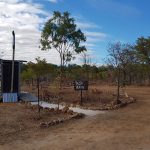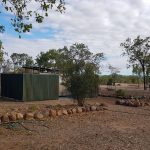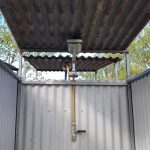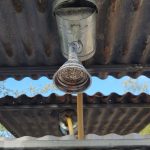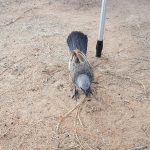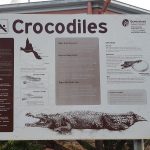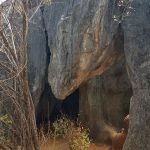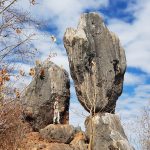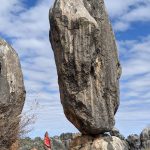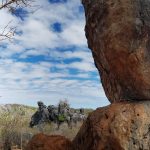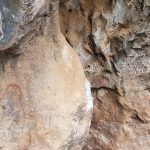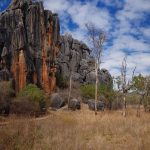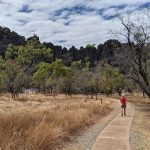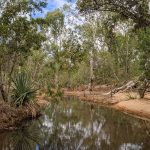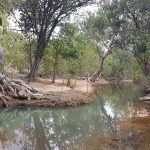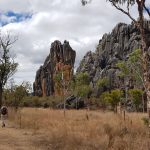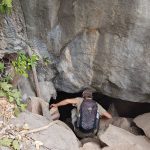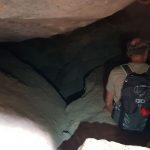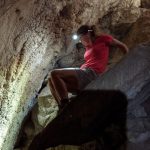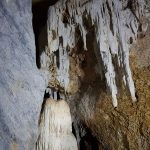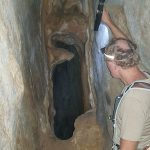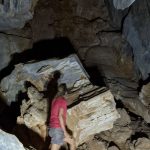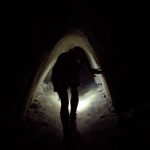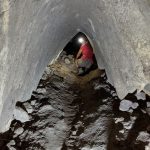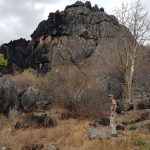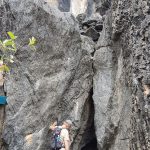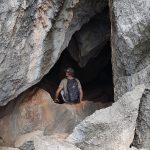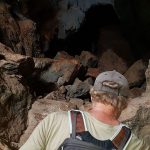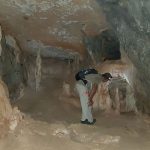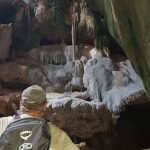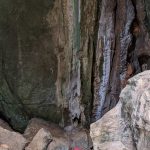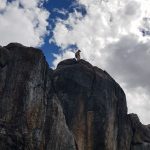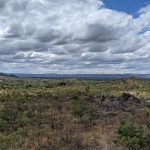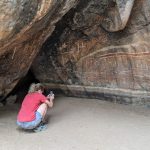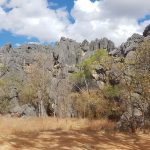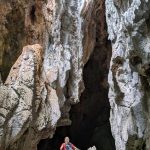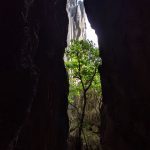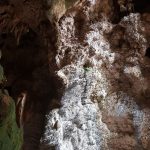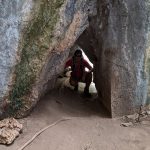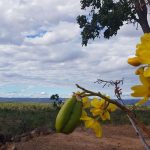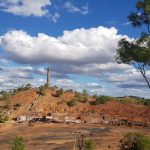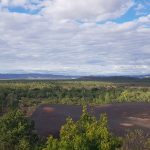Saturday 21st August 2021
Well, last night was the worst night sleep I have had in a little while. No fan, no air con and no king size bed eeekkk!! So, some of the first words of wisdom from my beautiful husband this morning were:- “I feel like I have been beaten up” followed by “You suck!” Ooppsss, looks like he didn’t get much sleep either, maybe we will need a Nanna nap this afternoon.
We were awake a lot earlier sleeping in the rooftop tent and booked our tours of the 3 caves for tomorrow and Monday. So we headed off for a walk to Balancing Rock and an 8km return walk in the Chillagoe Mungana Caves National Park. The weather was a lot hotter than we are used to (32°C) and the shade of the rainforest was missing but it was an enjoyable walk all the same. Our first stop was a little loop trail of the Balancing Rock (which I now know is caused by erosion), it is so amazing how these rocks balance. Then to the Wullumba Rock Art site, this was not too exciting as there are only a few drawings. Then the 2.8km hike to the start of the Royal Arch Cave tour. This was a mostly flat pleasant walk then winds past several striking limestone outcrops called tower karsts—features of world scientific interest. As you cross Chillagoe Creek, the huge paperbark trees line its banks. The track continues through open woodland featuring bloodwoods, Cooktown ironwoods, tea-trees and grevilleas. At the Royal Arch bluff—an imposing jagged limestone outcrop rising abruptly from the surrounding woodland—the vegetation changes again. Here there are scrubby deciduous plants such as native bauhinias and helicopter trees. We the walked back, when we crossed the creek we walked further along it to a lovely billabong.
After our hike we went to the freebie caves and did our own tours.
Bauhinia Cave is accessed via a dark, narrow crevice requiring a steep scramble down large boulders. In this small cave, there are interesting cave decorations such as cave coral.
Pompeii Cave can be accessed via a well-formed track with many steps through deciduous vine forest to the entrance—a cleft in the rock filled with large boulders, the remnants of a previous collapse. Inside this small cave, there are bats sleeping high in dark crevices and rock-wallabies hopping from boulder to boulder (I saw a rock wallaby on the outer section, it hopped quickly on the steep sharp cliff edges). A short but steep climb to the bottom reveals a dark passage and some attractive formations.
The Archways is a semi-open cave. The rock walls are sheer and amazingly beautiful.
Mungana Rock Art was an amazing piece of Aboriginal Art.
We then headed to the Chillagoe Smelters which is an excellent demonstration of the technology of mineral (copper, silver, lead and gold) smelting at the turn of the 20th century. An up-to-date plant was assembled and then modified repeatedly between 1901 and 1911 to meet local conditions. The physical remains at the Chillagoe Smelters preserve important evidence of historic smelting processes that are rare today.
A little bit of information about Chillagoe
“Limestone has been weathered, dissolved and re-formed by water to create spectacular caverns and passages, decorated by stalactites, stalagmites and flowstones.
Scientists believe the landscape around Chillagoe began to form about 400 million years ago, when limestone was deposited as calcareous mud and coral reefs on the bed of a shallow sea where Chillagoe is today. Subsequent tilting, folding and erosion exposed and weathered the limestone that today towers over the surrounding plains. Fluctuating groundwater levels slowly dissolved some of the limestone, creating caverns and passages, some of which have since been decorated by calcite stalactites, stalagmites and flowstones, deposited by surface waters penetrating through the rock.
Several bat species roost and breed in the dark caves. Chillagoe is one of five known nesting sites for the white-rumped swiftlet Aerodramus terraereginae. The caves are also home to spotted pythons Antaresia maculosa and a variety of insects and spiders. Fossilised bones of many animals, including those of the extinct giant kangaroo, have been found in the caves.
Aboriginal paintings are protected in the park. The Chillagoe Smelters site preserves relics of the State’s mining and industrial heritage dating back to the 1890s.”
- Our new home in Chillagoe..
- ..our backyard..
- ..our lavatory..
- ..our bathroom..
- ..our showers, cold of course..but it wasn’t too bad – I would say cool but just what was required after our long day in the heat today.
- ..watering can shower nozzle.
- Our breakfast buddies – the Apostlebird..
- A little bit of crocodile information.
- Heading to Balancing Rock..
- ..we passed some amazing structures – this one looks like a birds head – can you see its beak and eye..
- Balancing Rock..
- ..stands on a bit of an angle..
- ..looking from Balancing Rock in the distance at more rocky outcrops
- Wullumba Rock Art..
- ..the amazing rocks where the Wullumba Rock Art is housed..
- The rocks of the Royal Arch Cave – where we will tour tomorrow.
- Billabong at Chillagoe Creek..
- ..and again.
- Amazing rocks.
- The entrance to Bauhinia Cave..
- ..was a little challenging..
- ..steep and slippery..
- ..some stalactites and curtains..
- ..and a deel hole..
- ..amazing rocks.
- ..and tiny holes..
- ..through small tunnels.
- Outer Pompeii cave..
- ..thenthe entrance to Pompeii cave..
- ..as David enters Pompeii Cave..
- ..it was a very large cave with difficult climbing down..
- ..and then back up..
- ..with a little fairies cavern..
- ..it was really quite spectacular..
- ..and the colours and sheerness of the rocks was amazing..
- Dave managed to climb to the top of Pompeii Cave and where I am taking this photo is where a rocky wallaby jumped quickly passed me.
- View from the top of Pompeii Cave..
- The amazing rock art at Mungana
- A little warm today.
- The Archways rock formations..
- .was a semi open cave..
- ..with many crevices..
- ..and cave coral..
- ..and small tunnels.
- View from the Chillagoe Smelter site..
- The Smelter ruins..
- ..the view past the Slag Heap.


